 |
| June 09, 2015 | Volume 11 Issue 22 |
Mechanical News & Products
Designfax weekly eMagazine
Archives
Partners
Manufacturing Center
Product Spotlight
Modern Applications News
Metalworking Ideas For
Today's Job Shops
Tooling and Production
Strategies for large
metalworking plants
How ball spline coatings enhance performance and extend component life
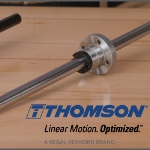 According to Thomson, "Precision ball splines have gained popularity as an ideal choice for applications that require low-friction linear and rotary motion. These components, which utilize a single splined shaft, enable complex movements in multiple directions." But how do you keep these ball splines performing at their peak for longer? Coatings can do the trick, and Thomson has three of them: black oxide, hard chrome plating, and nickel plating. Learn more about these coatings and which one makes the most sense for your precision ball spline solution.
According to Thomson, "Precision ball splines have gained popularity as an ideal choice for applications that require low-friction linear and rotary motion. These components, which utilize a single splined shaft, enable complex movements in multiple directions." But how do you keep these ball splines performing at their peak for longer? Coatings can do the trick, and Thomson has three of them: black oxide, hard chrome plating, and nickel plating. Learn more about these coatings and which one makes the most sense for your precision ball spline solution.
View the video.
Key factors for ball screw applications
 Learn the six key factors that should be considered when specifying ball screw assemblies in motion control applications. PCB Linear gathered a panel of experts in the field of linear motion to concentrate on this important topic -- particularly when it comes to the company's new miniature ball screw product line. Learn about precision and accuracy, orientation, speed and acceleration, duty cycle, linear motion travel, and load capacity. Podcast available too.
Learn the six key factors that should be considered when specifying ball screw assemblies in motion control applications. PCB Linear gathered a panel of experts in the field of linear motion to concentrate on this important topic -- particularly when it comes to the company's new miniature ball screw product line. Learn about precision and accuracy, orientation, speed and acceleration, duty cycle, linear motion travel, and load capacity. Podcast available too.
Read the PCB Linear blog.
3D printer uses pellet extrusion system instead of filament
 The latest addition to 3D Systems' industry-leading portfolio of EXT Titan Pellet systems is the EXT 800 Titan Pellet. With a build volume of 800 x 600 x 800 mm, this thermoplastics 3D printer harnesses the speed, reliability, and efficiency of the company's large-format pellet systems in a more compact unit with lower upfront investment. Use this machine to fabricate more modestly sized functional prototypes, tooling, fixtures, sand casting patterns, thermoforming molds, and end-use parts. Markedly faster than competing FFF and FDM printers, and up to 10X reduced material costs compared to filaments.
The latest addition to 3D Systems' industry-leading portfolio of EXT Titan Pellet systems is the EXT 800 Titan Pellet. With a build volume of 800 x 600 x 800 mm, this thermoplastics 3D printer harnesses the speed, reliability, and efficiency of the company's large-format pellet systems in a more compact unit with lower upfront investment. Use this machine to fabricate more modestly sized functional prototypes, tooling, fixtures, sand casting patterns, thermoforming molds, and end-use parts. Markedly faster than competing FFF and FDM printers, and up to 10X reduced material costs compared to filaments.
Learn more.
Test your knowledge: High-temp adhesives
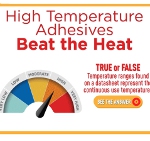 Put your knowledge to the test by trying to answer these key questions on how to choose the right high-temperature-resistant adhesive. The technical experts from Master Bond cover critical information necessary for the selection process, including questions on glass transition temperature and service temperature range. Some of the answers may surprise even the savviest of engineers.
Put your knowledge to the test by trying to answer these key questions on how to choose the right high-temperature-resistant adhesive. The technical experts from Master Bond cover critical information necessary for the selection process, including questions on glass transition temperature and service temperature range. Some of the answers may surprise even the savviest of engineers.
Take the quiz.
World's first current-carrying fastening technology
 PEM® eConnect™ current-carrying pins from Penn-Engineering provide superior electrical connections in applications that demand high performance from internal components, such as automotive electronics. This first-to-market tech provides repeatable, consistent electrical joints and superior installation unmatched by traditional fastening methods. Features include quick and secure automated installation, no hot spots or poor conductivity, and captivation options that include self-clinching and broaching styles.
PEM® eConnect™ current-carrying pins from Penn-Engineering provide superior electrical connections in applications that demand high performance from internal components, such as automotive electronics. This first-to-market tech provides repeatable, consistent electrical joints and superior installation unmatched by traditional fastening methods. Features include quick and secure automated installation, no hot spots or poor conductivity, and captivation options that include self-clinching and broaching styles.
Learn more about eConnect pins.
New flat quarter-turn clamping fastener
 IMAO Fixtureworks has expanded its One-Touch Fastener lineup to include a new quarter-turn clamping fastener that features an innovative flat design and is ideal for clamping in limited spaces. The QCFC flat quarter-turn fastener features a recessed body that protrudes only 2 mm from the mounted surface, a knob that rests flush inside the body, visible ON and OFF markings for safety, and an audible click when fully turned to clamped or unclamped position.
IMAO Fixtureworks has expanded its One-Touch Fastener lineup to include a new quarter-turn clamping fastener that features an innovative flat design and is ideal for clamping in limited spaces. The QCFC flat quarter-turn fastener features a recessed body that protrudes only 2 mm from the mounted surface, a knob that rests flush inside the body, visible ON and OFF markings for safety, and an audible click when fully turned to clamped or unclamped position.
Learn more.
Bellows and disc couplings with higher torque capacity
 Ruland Manufacturing now offers bellows and double disc couplings with bore sizes up to 1-3/4 in. or 45 mm for use in systems with torque up to 1,400 in.-lb (158 Nm). High-torque applications in precision semiconductor, solar, conveyor, and factory automation applications often use these shaft sizes. Ruland disc and bellows couplings accommodate all forms of misalignment, are zero-backlash, and have a balanced design for reduced vibration at speeds up to 10,000 rpm.
Ruland Manufacturing now offers bellows and double disc couplings with bore sizes up to 1-3/4 in. or 45 mm for use in systems with torque up to 1,400 in.-lb (158 Nm). High-torque applications in precision semiconductor, solar, conveyor, and factory automation applications often use these shaft sizes. Ruland disc and bellows couplings accommodate all forms of misalignment, are zero-backlash, and have a balanced design for reduced vibration at speeds up to 10,000 rpm.
Learn more.
Simplify your designs with slewing ring bearings
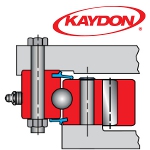 According to Kaydon Bearings, "A slewing ring bearing has rolling elements designed to create a reactive moment within the bearing's dimensions envelope to oppose applied (overturning) moment load," so you can use one bearing instead of two, reducing the height requirements, and even improve performance. Slewing ring bearings can also simplify a drive system by utilizing gear teeth on the inner or outer race. Learn all about slewing ring bearings in this informative article.
According to Kaydon Bearings, "A slewing ring bearing has rolling elements designed to create a reactive moment within the bearing's dimensions envelope to oppose applied (overturning) moment load," so you can use one bearing instead of two, reducing the height requirements, and even improve performance. Slewing ring bearings can also simplify a drive system by utilizing gear teeth on the inner or outer race. Learn all about slewing ring bearings in this informative article.
Read the Kaydon whitepaper.
Jet valve for ultra-small dispensing
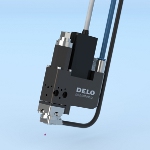 DELO's DELO-DOT PN5 LV pneumatic jet valve is designed for micro-dispensing low-viscosity adhesives and other media in miniaturized applications. Thanks to its compact design, it also requires very little space to install in production systems. Interchangeable nozzles with different diameters and a flexible, adjustable plunger stroke ensure precise and reliable applications at different droplet sizes. Volumes of as low as 1 nl can be achieved, which corresponds to droplet diameters of 250 µm or less.
DELO's DELO-DOT PN5 LV pneumatic jet valve is designed for micro-dispensing low-viscosity adhesives and other media in miniaturized applications. Thanks to its compact design, it also requires very little space to install in production systems. Interchangeable nozzles with different diameters and a flexible, adjustable plunger stroke ensure precise and reliable applications at different droplet sizes. Volumes of as low as 1 nl can be achieved, which corresponds to droplet diameters of 250 µm or less.
Learn more.
Stainless steel constant-torque flush-mount hinge
 Southco has introduced a flush-mount version of its popular and durable E6 constant-torque hinge. Its low-profile, corrosion-resistant package makes it an ideal solution for maximizing security, longevity, and aesthetics. It offers high torque for demanding applications while maintaining its low profile. Lots of uses.
Southco has introduced a flush-mount version of its popular and durable E6 constant-torque hinge. Its low-profile, corrosion-resistant package makes it an ideal solution for maximizing security, longevity, and aesthetics. It offers high torque for demanding applications while maintaining its low profile. Lots of uses.
Learn more.
Claw vacuum pump for industrial applications
 Vacuum expert Leybold has added a new model to its proven CLAWVAC dry claw vacuum pump series: the CLAWVAC CP B. This innovative, rough vacuum pump, designed for robust processes including food processing, material handling, and environmental industries, is powerful, energy efficient, and easy to clean. The intuitive handling of this unit is mainly due to its functional design, which features a pair of claws that rotate in the cylinder with no contact or wear. Its separate gearbox prevents oil contamination. The design ensures short downtimes and long service intervals: 20,000 hr between oil changes and up to 48,000 hr between general overhauls.
Vacuum expert Leybold has added a new model to its proven CLAWVAC dry claw vacuum pump series: the CLAWVAC CP B. This innovative, rough vacuum pump, designed for robust processes including food processing, material handling, and environmental industries, is powerful, energy efficient, and easy to clean. The intuitive handling of this unit is mainly due to its functional design, which features a pair of claws that rotate in the cylinder with no contact or wear. Its separate gearbox prevents oil contamination. The design ensures short downtimes and long service intervals: 20,000 hr between oil changes and up to 48,000 hr between general overhauls.
Learn more.
DualVee linear guides and tracks used in warehousing
 See how Bishop-Wisecarver's DualVee® motion tech can add huge benefits to warehousing operations. This video highlights two applications: a manual storage and retrieval system and an automated storage and retrieval system of long aerospace-grade carbon fiber in sub-zero temps. Patented DualVee guides and tracks keep operations running smoothly.
See how Bishop-Wisecarver's DualVee® motion tech can add huge benefits to warehousing operations. This video highlights two applications: a manual storage and retrieval system and an automated storage and retrieval system of long aerospace-grade carbon fiber in sub-zero temps. Patented DualVee guides and tracks keep operations running smoothly.
View the video.
Build-to-order knobs and hand hardware
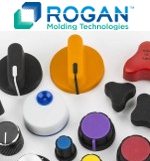 Rogan Corp.'s innovative use of two-shot plastic injection and insert molding has been providing customers with high-quality plastic clamping knobs, levers, and control knobs for almost 90 years. Rogan offers concurrent engineering, product design, and assistance in material selection to ensure customer satisfaction for standard or customized parts, with a focus on cost optimization and on-time delivery. Custom colors, markings, decorative inlays, or engineered materials to meet special requirements, such as adding extra strength or utilizing flame-retardant material, are all offered.
Rogan Corp.'s innovative use of two-shot plastic injection and insert molding has been providing customers with high-quality plastic clamping knobs, levers, and control knobs for almost 90 years. Rogan offers concurrent engineering, product design, and assistance in material selection to ensure customer satisfaction for standard or customized parts, with a focus on cost optimization and on-time delivery. Custom colors, markings, decorative inlays, or engineered materials to meet special requirements, such as adding extra strength or utilizing flame-retardant material, are all offered.
Learn more.
Slewing ring bearing made of wood and plastic
 The PRT-02-30-WPC slewing ring bearing is another step forward by igus toward integrating renewable raw materials into industrial production. Made of 50% wood and 50% high-performance plastics, the cost-effective and lubrication-free slewing ring bearing balances strength and durability with a proven low CO2 footprint. The materials incorporate solid lubricants, making the new slewing ring bearing smooth running and maintenance-free.
The PRT-02-30-WPC slewing ring bearing is another step forward by igus toward integrating renewable raw materials into industrial production. Made of 50% wood and 50% high-performance plastics, the cost-effective and lubrication-free slewing ring bearing balances strength and durability with a proven low CO2 footprint. The materials incorporate solid lubricants, making the new slewing ring bearing smooth running and maintenance-free.
Learn more.
Flex Locators for quick fixture changeover
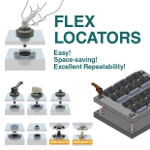 Flex Locators from Fixtureworks are designed for quick changeover of small and large fixtures, automation components, and more. They are ideal for applications that require frequent disassembly, providing excellent repeatability for locating and clamping in a single operation. Manual and pneumatic versions are available. Just turn the handle, knob, or screw!
Flex Locators from Fixtureworks are designed for quick changeover of small and large fixtures, automation components, and more. They are ideal for applications that require frequent disassembly, providing excellent repeatability for locating and clamping in a single operation. Manual and pneumatic versions are available. Just turn the handle, knob, or screw!
View the video.
Thin coating on condensers could make power plants way more efficient
Graphene layer one atom thick could quadruple rate of condensation heat transfer in generating plants.
By David L. Chandler, MIT
Most of the world's electricity-producing power plants -- whether powered by coal, natural gas, or nuclear fission -- make electricity by generating steam that turns a turbine. That steam then is condensed back to water, and the cycle begins again.
But the condensers that collect the steam are quite inefficient, and improving them could make a big difference in overall power plant efficiency.
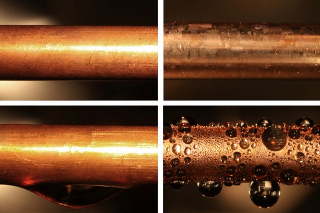
An uncoated copper condenser tube (top left) is shown next to a similar tube coated with graphene (top right). When exposed to water vapor at 100 deg C, the uncoated tube produces an inefficient water film (bottom left), while the coated one shows the more desirable dropwise condensation (bottom right). [Image: MIT]
Now, a team of researchers at MIT has developed a way of coating these condenser surfaces with a layer of graphene, just one atom thick, and found that this can improve the rate of heat transfer by a factor of four -- and potentially even more than that, with further work. And unlike polymer coatings, the graphene coatings have proven to be highly durable in laboratory tests.
The findings are reported in the journal Nano Letters by MIT graduate student Daniel Preston, professors Evelyn Wang and Jing Kong, and two others. The improvement in condenser heat transfer, which is just one step in the power-production cycle, could lead to an overall improvement in power plant efficiency of 2 to 3 percent based on figures from the Electric Power Research Institute, Preston says -- enough to make a significant dent in global carbon emissions, since such plants represent the vast majority of the world's electricity generation. "That translates into millions of dollars per power plant per year," he explains.
There are two basic ways in which the condensers -- which may take the form of coiled metal tubes, often made of copper -- interact with the flow of steam. In some cases, the steam condenses to form a thin sheet of water that coats the surface; in others it forms water droplets that are pulled from the surface by gravity.
When the steam forms a film, Preston explains, that impedes heat transfer -- and thus reduces the efficiency -- of condensation. So the goal of much research has been to enhance droplet formation on these surfaces by making them water repelling.
Often this has been accomplished using polymer coatings, but these tend to degrade rapidly in the high heat and humidity of a power plant. And when the coatings are made thicker to reduce that degradation, the coatings themselves impede heat transfer.
"We thought graphene could be useful," Preston says, "since we know it is hydrophobic by nature." So he and his colleagues decided to test both graphene's ability to shed water, and its durability, under typical power plant conditions -- an environment of pure water vapor at 100 deg C.
They found that the single-atom-thick coating of graphene did indeed improve heat transfer fourfold compared with surfaces where the condensate forms sheets of water, such as bare metals. Further calculations showed that optimizing temperature differences could boost this improvement five to seven times. The researchers also showed that after two full weeks under such conditions, there was no measurable degradation in the graphene's performance.
By comparison, similar tests using a common water-repelling coating showed that the coating began to degrade within just three hours, Preston says, and failed completely within 12 hours.
Because the process used to coat the graphene on the copper surface -- called chemical vapor deposition -- has been tested extensively, the new method could be ready for testing under real-world conditions "in as little as a year," Preston says. And the process should be easily scalable to power plant-sized condenser coils.
"This work is extremely significant because, to my knowledge, it is the first report of durable dropwise condensation with a single-layer surface coating," says Jonathan Boreyko, an assistant professor of biomedical engineering and mechanics at Virginia Tech who has studied condensation on superhydrophobic surface. "These findings are somewhat surprising and very exciting."
Boreyko, who was not involved in the research, adds that this method, if proven through further testing, "could significantly improve the efficiency of power plants and other systems that utilize condensers."
The research team also included MIT postdoc Daniela Mafra and former postdoc Nenad Miljkovic, who is now an assistant professor at the University of Illinois at Urbana-Champaign. The work was supported by the Office of Naval Research and the National Science Foundation.
Published June 2015
Rate this article
View our terms of use and privacy policy


